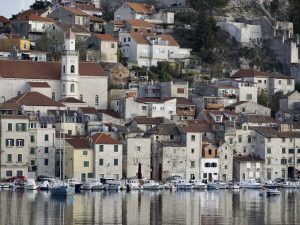For Thanksgiving weekend, we rented a car to see some other places in Istria. We also booked two nights in hotels since our Air BnB in Pula was relatively inexpensive. Like our road trips from Pontevedra, it felt great just heading off with nothing more than a small backpack and leaving behind the bulk of our stuff.
We didn’t have the best weather but we also didn’t have the worst. We visited several towns and some common themes emerged but, of course, each town had its own feel. Most of these towns had been ruled by the Venetians for a couple hundred years. Not surprisingly, the architecture had a Venetian feel, especially the shape of the windows. We also the lion symbol of St. Mark (Venice’s patron saint) over and over again in the stonework. Rovinj, especially, had a Venetian spirit with its walls being surrounded immediately by the water.
One other challenge we had was renting a car in the off season. In Pula, the offices for the major rental companies are at the airport (five miles from the city center). The bigger issues is that the airport has almost no flights coming or going in the winter, so the car rental agencies are by appointment only. We booked the car online through our USAA discount so the “appointment only” business hours was not clear to us until we arrived at the airport by taxi an hour later than we had booked the reservation online (no big deal, right?). Well, the agent had waited an hour for us but gave up shortly before our arrival and was just leaving the airport in her car when we called her cell phone (her number was thankfully posted at the desk). She answered and thankfully agreed to come back to the airport to process our request. Did I mention it was pouring rain and the agent got wet both leaving and returning. We felt terrible and apologized profusely. I was afraid the entire checkout experience would be miserable, but thankfully she quickly brightened up and ultimately went above and beyond the call of duty as she spent 20 minutes giving us advice on what to see and what not to see in the off season. Her advice was on point and made our next two days much more meaningful than if we hadn’t met her and executed the plan we had on paper. We even canceled our reservation at a “thermal spa”, which she told us is more or less an architectural relic of the Cold War era construction and is depressing as hell unless you are going just for the therapeutic properties of the hot springs; “only old people go there”, she told us. Run away!
Most of all, she pointed us to Opatjia near Rijeka and that turned out to be terrific. I told her she would make a great travel agent and she said she really enjoys working for the car rental company and just wants people to appreciate the beauty and friendliness of Croatia. Now, I don’t want to come across like I’m bashing on American work culture, but this level of enthusiasm, optimism, and genuine helpfulness is something I simply have never encountered with American airports or car rentals. We rented a 1 liter, 3-cylinder Kia Picanto, which felt just a couple Shetland ponies more powerful than the Fiat 500 we had rented in Spain. Good thing we wouldn’t be driving in any mountains. Or would we?

Unlike our extended explorations of Pula, we didn’t have much time to spend in any of the towns so our experience was more about feeling the mood of each place and we recognize that all we were getting was a snapshot that would be completely different if taken at a another hour or the day, day of the week, or month of the year. We also discovered the pace of activity in other towns was much slower than Pula and became increasingly grateful for making the decision to make it our base, where its “working town” character burns through the off-season malaise with a vibrant and bustling local population. In contrast, walking around Rovinj was practically depressing because it was so bereft of people. We are told that Rovinj in the summertime is wall to wall with humanity. Hard to imagine.
Rovinj
Rovinj pronounced ROH-veen or roh-VEEN; sources vary on which syllable is accented. But it definitely rhymes with bean or seen and does NOT rhyme with hinge or singe (or winge for any Australians out there).
Rovinj was ruled by the Venetians for just over 500 years (1283-1797). It was once set exclusively on a small island but the channel to the mainland was filled in so now it sits on more of a peninsula. The city doesn’t have canals but the way its buildings sit right on the Adriatic makes Rovinj look a lot like Venice. Many of the signs in Rovinj are written in both Croatian and Italian, which reflects not only the period of Venetian rule but also the 25 years of Italian administration between the world wars. Apparently, some of the local population still speaks a Romance-based language called Istriot. How would we know though? We barely saw any people at all.
Rovinj is billed in the guidebooks as the crown jewel of Istria, but that was not our experience. Of all the coastal towns we visited, Rovinj was the most quiet, the most windy, the most overcast, and the most chilly. This was partly because we arrived at 10 a.m. so the sun had only been up for two hours and the town was still coming to life. We didn’t have a bad experience, but it was not what you read about in Fodor’s or Rick Steve’s. Rovinj felt like a ghost town and the sole person had a conversation with was a shop owner who pleaded for me to buy a refrigerator magnet. Normally, I’m pretty good at deflecting the hard sell but this guy was practically begging and I figured we were probably the only tourists he would see all day, so I gave in and spent the seven Euro to become the proud owner of a donkey magnet made from small sea shells. We have been careful not to accumulate stuff so we ended up leaving that magnet on the water heater in Pula as our contribution to the cuteness of that apartment. Besides, not only do we not need another refrigerator magnet but we don’t even own a refrigerator at the moment.
The skies were grey but the visibility across the Adriatic was exceptionally clear in that crisp winter way. We thought we could see clouds on the horizon to the north but then figured out we were looking at the to Dolomite mountains in Italy some 70 miles away.
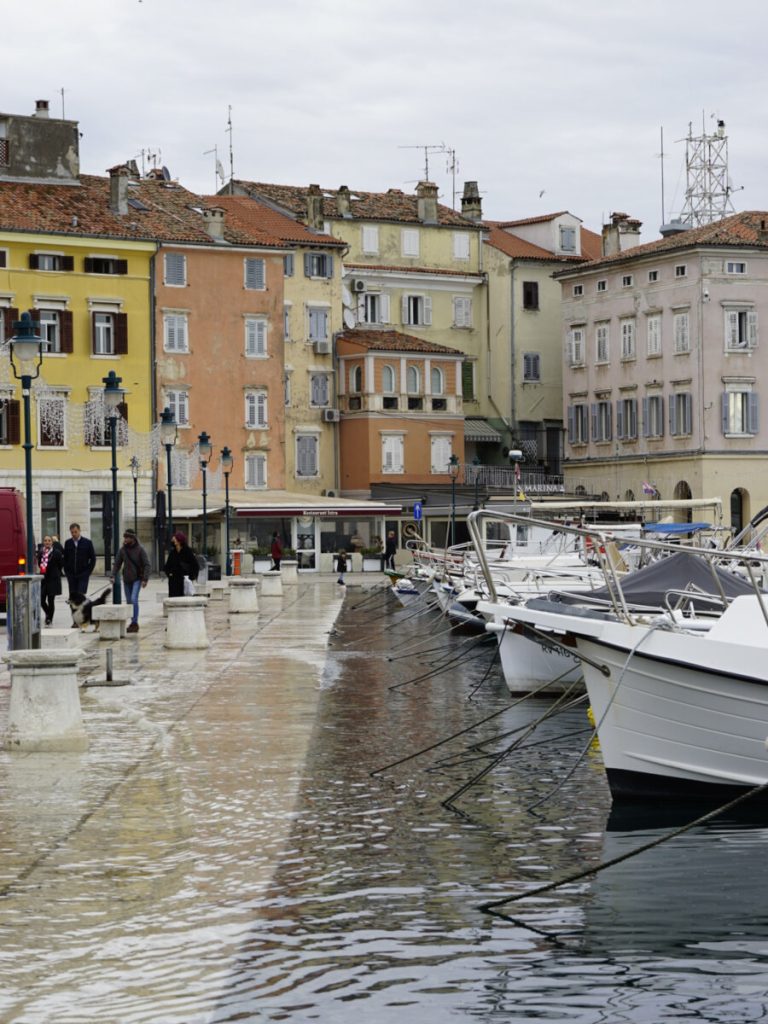
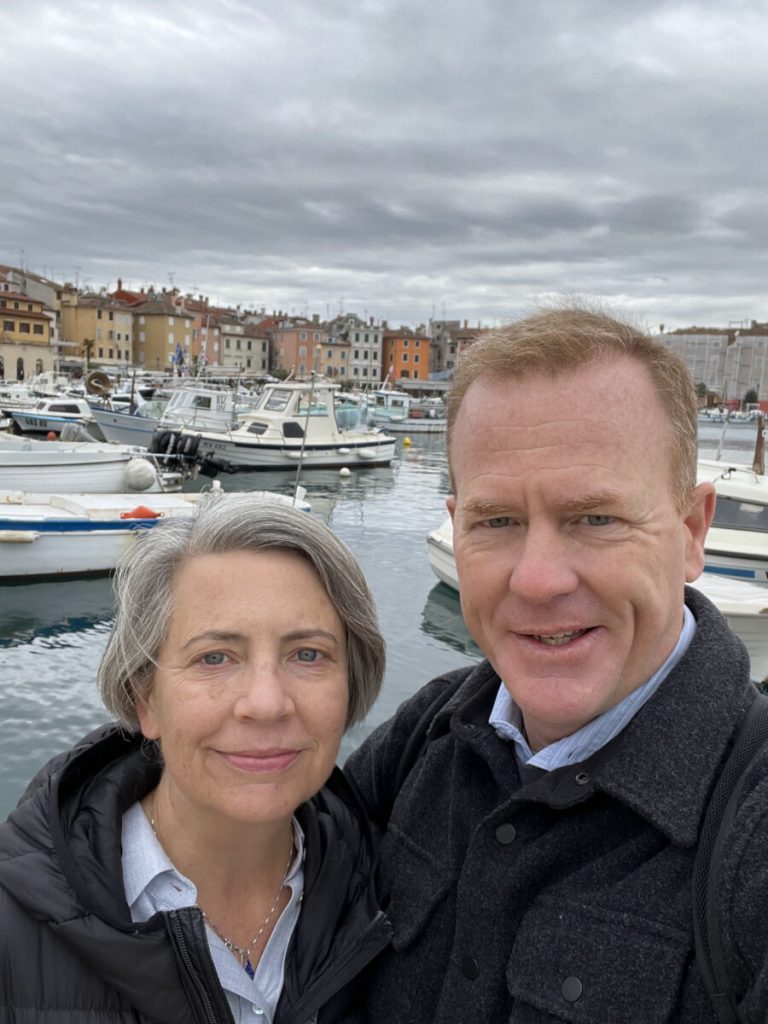




In the third photo below, I initially thought the cross was a weak attempt at mimicking a cruceiro (my Galician bias perhaps), but then I read a plaque which said the monument marks the location where the remains of St. Euphemia, the patron saint of Rovinj, were brought into the city in the year 800 A.D. The big church at the top of the hill is the Basilica of Saint Euphemia where her remains are kept.
St Euphemia had been fed to wild animals at an arena in northern Turkey in the 4th century during the reign of the Roman emperor Diocletian (who you will hear more about when we visit Split). She refused to worship the Roman gods and thus became a Christian martyr. If you want to read about how her remains made it from the coast of the Black Sea to a hilltop town in the Adriatic, this link is an interesting read and brings the story to life.
The fourth photo below shows the door which once marked the limit of the town walls (you can see an interesting depiction of Rovinj during the Middle Ages in the St Euphemia web link above; Rovinj looks old but it has definitely changed over time).
In the last photo, we didn’t know if at the time but you can see the donkey magnet salesman lying in wait halfway down the street. I regret not taking a photo of the seashell donkey magnet, too.





Lim Fjord and Vrsar
The town of Vrsar is only four miles up the coast from Rovinj but to get there you have to drive a looping route inland to get around the Lim Fjord, which is a unique geologic feature on an otherwise even coastline. To be clear, this is a fjord in the same way the Appalachians are mountains. It has the essential features of a fjord but it’s far less dramatic than a Norwegian fjord or even the calanques near Marseille that we saw in September. The other challenge with Lim fjord is finding a viewpoint that gets above the gentleness of the slope and the height of the trees. We stopped at one roadside lookout but the vegetation prevented us from getting a good view. We stopped at another and caught enough of a glimpse to realize this fjord’s magnificence is entirely relative. Add in the grey sky and its dampening effect on the color of the water. We were somewhat underwhelmed. I’m sure Lim Fjord has a lovely personality; if only it weren’t so shy and retreating.
Vrsar is a nice town and has some of the classic features of an Istrian coastal settlement including a hill, a church with a straight-lined bell tower, and a nice little harbor. We walked the town for 20 minutes, drove around the harbor, and called it good. If you have cruised the Adriatic coast on a boat in the summer, you likely have a better impression of Vrsar than if you arrive in a Kia Picanto in late November. And in the spirit of Croatian superlatives, Vrsar has is “the home of the large Koversada Naturist Campsite, the oldest in Istria“.



Porec (pronounced PO-ruhch)
The c in Porec has the upside down caret (^) over the letter c, so Porec is pronounced similar to the word porridge. Although I know the ALT+code for that character, I am refraining from Croatia characters because it seems to make the word processing software’s head hurt.
Rovinj and Porec both have populations of about 15,000 permanent inhabitants (this number is much higher in the summer time). After Rovinj and Vrsar, we were fully expecting Porec to be another off season ghost town, but its population was out and about and the town had a much more lively and welcoming feel. Porec is less than one-third the size of Pula but we felt a similar vibe there. We also saw some blue sky and sunshine at this point, which helped lift our spirit of adventure.
Porec doesn’t have a hill, but it’s built on a peninsula, has the classic bell tower attached to the church, a nice harbor, and a network of narrow stone laden streets. The themes of these Istrian towns was becoming apparent to us pretty quick.
We had a nice lunch just off the main square in a restaurant called the Cotton Club. It was about the only restaurant open so we chose it mainly through simple elimination. They had maybe the best garlic bread I’ve ever eaten and we enjoyed our meal very much. It wasn’t until afterwards, though, that I read the backstory on this restaurant on the Cotton Club’s website, which is either more inflated than a Navy FITREP or we were dining in the midst of royalty and rock stars and didn’t even know it. This is a restaurant that is not afraid of taking itself very seriously.
One other common theme we noticed in these coastal towns is the accessibility of the waterfront for swimming. Istria does not have an abundance of beaches but the water is crystal clear and inviting even in November and even in the busy harbors of these seaside towns. In the first photo below, this “swimming pool ladder” is a very common sight along the waterfront of Istrian towns and enables swimmers to use the pier like a false beach and to swim safely and easily in the harbor. Also note the Italians mountains are still visible on the horizon with their snow-capped peaks shining in the sun. In the second and second to last photos, if you look at the windows of the buildings, the style is very similar to Venice (500 years of rule has that kind of effect).

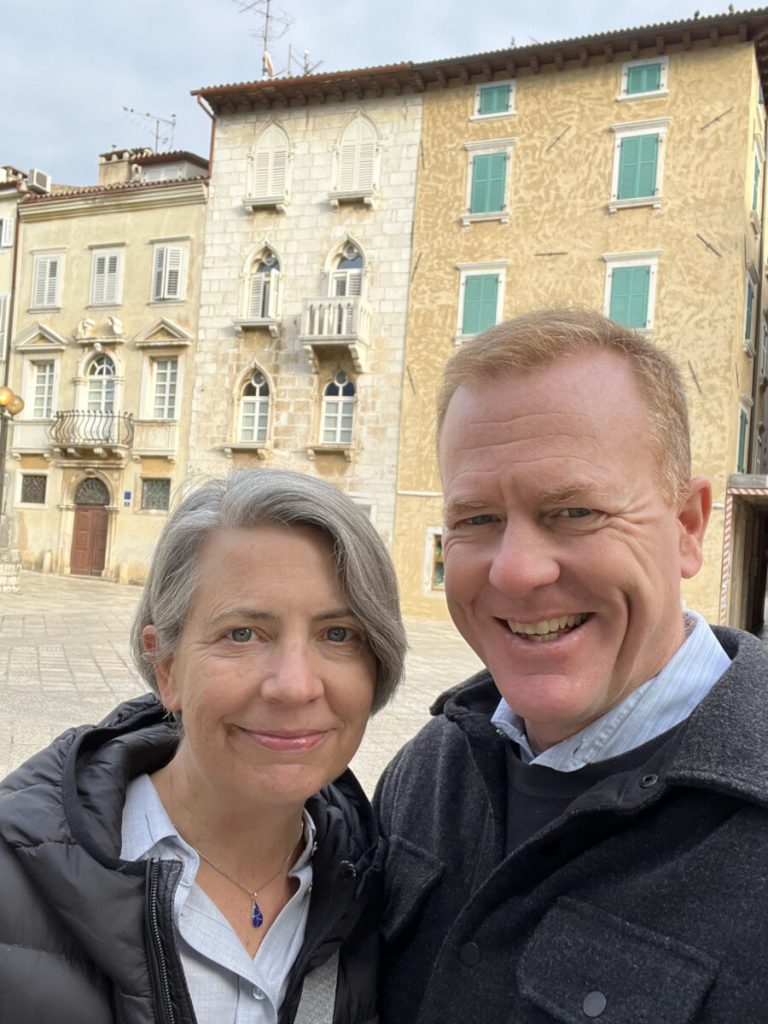




Vodnjan (pronounced vone-YAHN)
We turned back toward Pula in the mid-afternoon and decided to visit the town of Vodnjan on the way, which is only about 8 miles north of Pula. Although Vodnjan is not a port town like the others we visited, it is only a few miles from the water and sits on the fertile Istrian lowlands in the middle of a large concentration of olive trees, making Vodnjan something of the olive oil center of commerce.
A few miles before we got to Vodnjan, we stopped along the side of the road where you could see the fields of olive trees in the foreground and the Adriatic in the background with the golden hour of sunlight just starting. We got a couple great photos, including a cross and little chapel in the middle of this idyllic setting.
We recalled our host in Pula mentioning that Vodnjan was worth visiting but was a bit “shobby”. Lyn and I discussed this afterward and tried figuring out if she had been saying the town is “shabby”. She spoke somewhat favorably about so this was a bit of a mixed message. We read up on Vodnjan and learned that some of its backstreets had large “urban art” murals, which are inconsistent with its otherwise quaint, old world charm. When we arrived in town, we parked the car and took a walk. It didn’t take long to figure out that a number of buildings in Vodnjan had been neglected for too long and were falling down from the inside out. It was only a fraction of the structures, but the more we wandered and found some of the narrow back alleys, the more we were pretty certain our host (whose full-time job is teaching English) had known exactly what word to use in describing the town. Shabbiness has its own charm of course and we found the full spectrum on display as we walked around Vodnjan and captured some late afternoon photos.


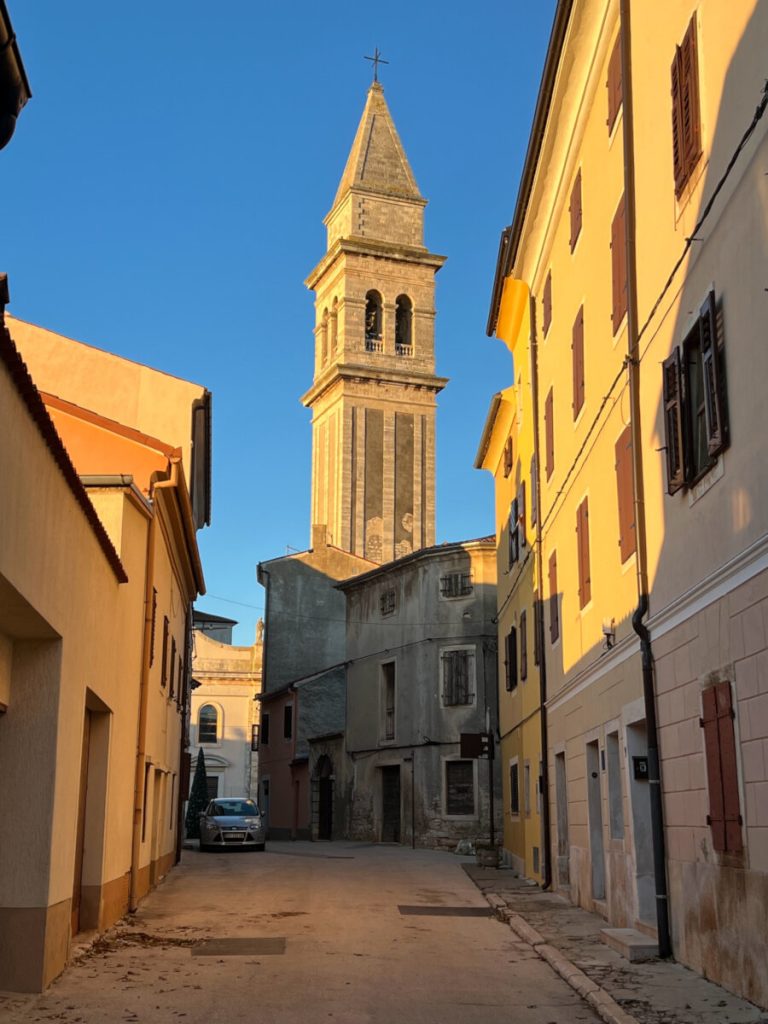




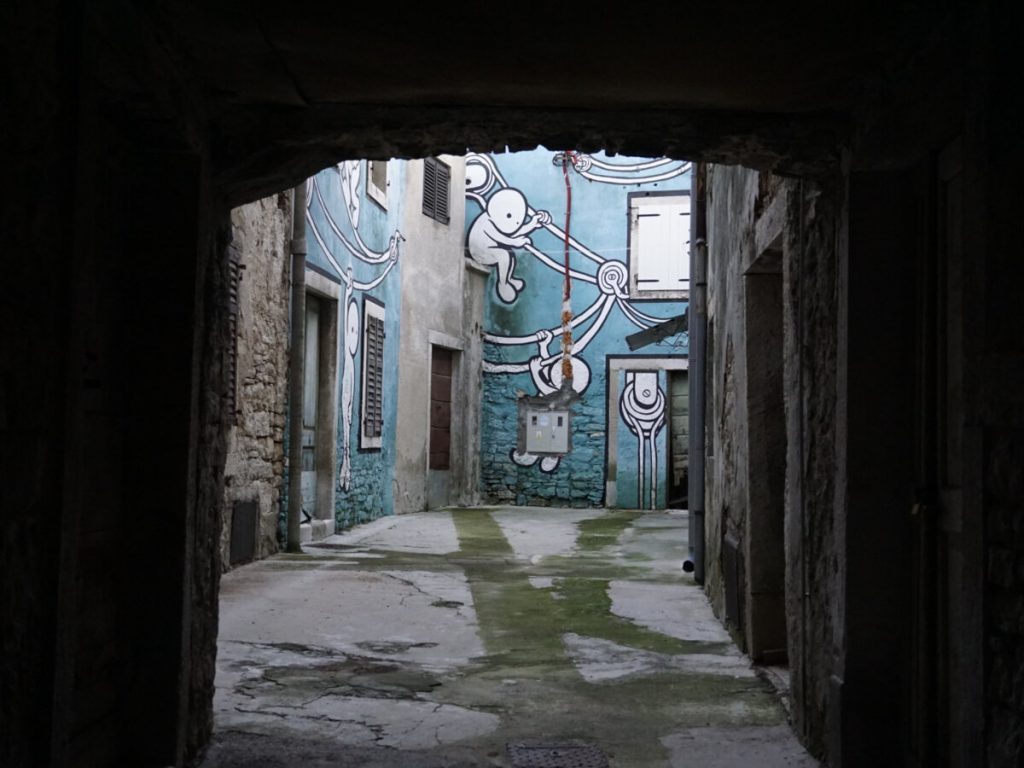


Brijuni Island and Fazana
We could see the conditions were ripe for an awesome sunset. Even though Vodnjan is built on a small hill, it’s one of those towns where you just couldn’t see over the walls enough to find a vista of the surrounding rural area. We hopped in the car and drove toward the town of Fazana (has a character over the z; it’s pronounced fa-JHA-na), which sits on the coast just a little west of Vodjnan. We were literally racing the sunset and fortunately found a stretch in the road with a great view looking down to the Adriatic and Brijuni Island just offshore (also known as Brioni Island in Italian and in the Istrian dialect). Fazana is a very pleasant beach town with the augmented role of serving as the ferry base for getting to Brijuni Island.
If we had a few more days and a guarantee of good weather, we would have added Brijuni Island to our list, not just because it looks pretty but because of its historical significance as a fortification, as an Austro-Hungarian riviera, as a privately owned Island that stayed in Austrian hands for over a decade after WWI while the rest of Istria became Italian, as summer residence of Yugoslavia’s Cold War leader Marshal Tito, as the host of the first Non-Aligned Nations conference during the Cold War, and as the and as the site of the July 1991 Brioni Agreement, which was a major stepping stone to cleaving off a chunk of the the former Socialist Federal Republic of Yugoslavia and the subsequent recognition of Slovenia and Croatia as independent nations in early 1992. And if that wasn’t enough, Brioni is now a national park and includes a safari park created with animals donated to Tito for his role in forging the Non-Aligned Nations concept in the early 1950s (a seemingly idealistic movement for nations to stay out of the fray in the global polarization of the Cold War; it wasn’t quite that simple though).
Brijuni’s other contribution to the world is its quarries. If you’ve ever visited Venice, Milan, or Berlin, chances are you have touched a piece of Brijuni in the stone buildings, stone churches, and streets of these magnificent cities.




Saving the best for last
After watching sunset in Fazana, we drove back to our place in Pula. This was the Wednesday before Thanksgiving Day and part of our motivation for renting the car and getting on the road was to distract ourselves from being away from our family on the most family-centric holiday of the year.
Thankfully, our three kids were all surrounded by plenty of love despite their absentee parents selfishly staying overseas on a four-month trip. Our oldest spent Thanksgiving with my little sister in Vermont, including a Boston Celtics game on Wednesday night (they won). Our youngest spent Thanksgiving with Lyn’s older sister in Wisconsin, which was his first break from being a college freshman. And our middle child drove from Boston to Virginia Beach and spent the holiday with his girlfriend’s family, which was something of a homecoming for him even though we no longer have a home there.
We’d seen a lot in a day but by far the best moment was doing a Facetime call with our three kids to have a virtual “talk around the table” ahead of the Thanksgiving Day and the tyranny of the time change. The kids probably won’t be happy with me sharing this screenshot from my phone, but it represents by far the best moment of our day. Christmas will be a totally different story and we are getting excited about meeting up with the kids in southern Spain.

Considering the relatively compact size of Istria, its numerous seaside towns have a lot of character which, like Croatia itself, have been shaped by a lot of different empires at this geographic crossroads where the west, the east, and the Mediterranean all meet.
After an excellent pizza and some World Cup group stage action at a restaurant in downtown Pula, we prepared to visit the center of Istria and its mountain towns.



